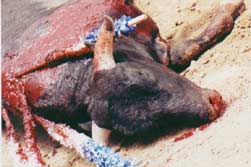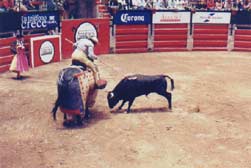Bullfighting
 Photo Credit: SHARK
Photo Credit: SHARK
Bullfighting is a traditional Latin American spectacle in which bulls bred to fight are tortured by armed men on horseback, then killed by a matador. Starved, beaten, isolated, and drugged before the “fight,” the bull is so debilitated that he cannot defend himself. After being stabbed, speared, and harpooned, the suffering animal is killed.
Bulls
Bulls are generally calm, peaceful animals who behave violently only when defending themselves or their territory. For this reason, bulls must be expressly bred for bullfighting. They are bred to be slow, simple, and predictable; in other words, easy to slaughter. Some bulls are even bred to return to the bullfighter and the torture he inflicts, therein giving the mistaken impression that the animal is fighting a fair fight.
Before the "Fight"
Heavyweights  Photo Credit: SHARKare tied to the bull’s neck for weeks before the fight to weaken him. Workers rub petroleum into his eyes to obscure his vision and beat the bull’s kidneys repeatedly. They give him tranquilizers, laxatives, and drugs that induce paralysis or a hypnotized state. They feed the bull a great deal of salt so that he will drink excessive amounts of water, become bloated and, consequently, slow. The vast majority of bulls are forced to undergo afeitado, the cutting down or filing of the horns. Part of the bull’s horns is sawed off so that he cannot thrust at his opponent properly. All the while, the bullfighter is practicing his techniques on underweight heifers.
Photo Credit: SHARKare tied to the bull’s neck for weeks before the fight to weaken him. Workers rub petroleum into his eyes to obscure his vision and beat the bull’s kidneys repeatedly. They give him tranquilizers, laxatives, and drugs that induce paralysis or a hypnotized state. They feed the bull a great deal of salt so that he will drink excessive amounts of water, become bloated and, consequently, slow. The vast majority of bulls are forced to undergo afeitado, the cutting down or filing of the horns. Part of the bull’s horns is sawed off so that he cannot thrust at his opponent properly. All the while, the bullfighter is practicing his techniques on underweight heifers.
For hours before to the bullfight, the bull is held in a tiny, dark isolation cell. He is not given food or water. Confused and anxious, the bull misses the company of his herd. Just before entering the bullring, he is harpooned, causing him to bleed, then released into the bright light of the arena.
The Acts of the Bullfight
Act 1
Each bullfighter has a group of men assist him in the ring; a bullfighter on a horse is named a picador. During act one, the picadores damage the bull’s neck muscles by stabbing him repeatedly with a spiked lance. The riders impale their spears into the bull's back and shoulders, tearing the muscles and tendons the animal needs to defend himself. He suffers serious blood loss.
Act 2
The picadores strike the bull with barbed harpoons, further crippling him. He experiences tissue damage and sometimes internal bleeding. He may be too weak to raise his head or walk. He may try to crawl away or collapse. Or he may urinate and defecate uncontrollably. The spears dig into the bull’s back for the rest of the “fight.”
Act 3 Photo Credit: SHARK
Photo Credit: SHARK
The matador attempts to stab the bull in the heart with his sword. While theoretically, the bull should die instantly, the killer usually misses. He often mistakenly stabs the bull in the lungs, which sometimes causes the animal to vomit blood out of his nose and mouth. After stabbing the bull (usually again and again) with the long sword, his killers try to slice up his internal organs so that he will collapse if he has not already done so. As a result, the bull may be paralyzed, but still conscious. The bullfighters frequently cut the bull’s spinal cord with a dagger to make his death more visually appealing to the spectators. His ears and tail are then cut off. The bull is dragged around the bullring while the audience cheers. If he is still alive at this point, he is subsequently killed.
Horse
The horses used in bullfighting are also routinely drugged. Workers typically stuff wet newspaper into their ears so that they will be unable to hear, and they are sometimes blindfolded to prevent them from running away. Their vocal cords are often cut so the crowd will not hear their screams. Men on horseback repeatedly spear the bull, while the horses bear the brunt of the “fight;” matadors like bullfighting from horseback because they stand little chance of being hurt. Although the horses are sometimes wrapped in padding, they are regularly injured in bullrings and approximately 200 are killed each year. Photo Credit: SHARK
Photo Credit: SHARK
Novillada: Baby Bullfights
During novillada, baby bulls are brought into a small arena where audience members, including children, stab them to death. Spectators cut off the ear and tail of the dying calf. Emaciated heifers are also killed in such a way.
"Bloodless Bullfights"
During “bloodless bullfights,” the bull is not murdered in the ring, though it will frequently be killed immediately afterward. Such “fights” are legal in many U.S. states.
Public Opinion
The majority of citizens in both Spain and Mexico oppose bullfighting. Their governments will not ban the “sport,” however, because of the revenue it generates.
You Can Help:
If you are planning to visit a country that permits bullfighting, refuse to stay at a resort with a bullfighting arena. Write a letter to the resort’s owner explaining why you will not stay there.
- Write to companies that sponsor bullfights and explain your disapproval.
- If you live in a city that permits bullfights or “bloodless bullfights,” stage a protest.
- Educate others about the horrors of bullfighting.











